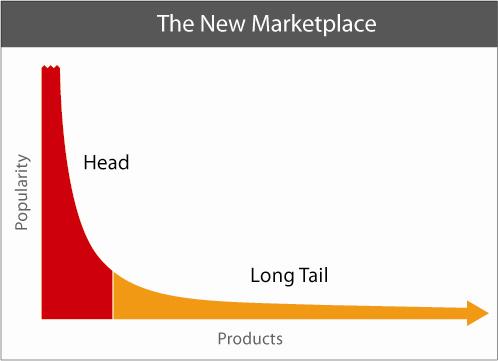In this article we examine the future of the long tail keyword. Which does sound rather like an exotic animal! Whilst we can’t promise to match the flair of a David Attenborough documentary, we will explore the development and purpose of the long tail keyword and assess its likely relevance to multichannel marketing in the future.
The term “long tail” originated from a book of the same name by Chris Anderson. The book espouses the theory that there is a “New Marketplace” in western culture and economy i.e. the online marketplace is moving away from focussing on a relatively small number of mainstream products in favour of a much larger number of niche products (The tail).
This change has had a profound impact on the way that marketers need to operate. If you are trying to reach consumers with a niche product or service then you need to understand the kind of search phrases that they are likely to use to find that exact product or service.
Long tail keywords consist of over four words that are more specific and less common than other keywords but that define very clearly what the consumer is looking for i.e. They are specific.

However, the issue for marketers is whether the time and effort spent in identifying and incorporating long tail keywords is justified. The assumptions to date are that shorter keywords are likely to generate more hits, whereas long tail keywords have a higher probability of conversion. But how does this reflect into actual results?
At Xcite Digital we were interested in recent research from Clicteq and PPC Hero which suggests that long tail keywords are now almost obsolete in terms of their use in AdWords. Historically, search marketers have accepted the premise in the diagram below ie that a small percentage of traffic comes from short keywords as compared to around 70% of traffic comes from long
tail keywords.

However recent analysis indicates that as much as 52% of traffic is now generated by single phrase keywords. SO the balance has shifted from long tail to short keywords.
The three main points around this are:
1. Short keywords generate more conversions than long tail keywords
A marketer’s time is better spent working on the top 20% of keywords rather than long tail keywords. Data from PPC Hero’s case study that showed that of 138,638 keywords that are 5+ words in length only 15 out of 608 conversions – 2.4% – were generated.

The research reinforced these findings. It would seem that your time would be better spent optimising the top 20% of keywords that are now generating 85% of your conversions, instead of long tail keywords.
The findings also line up with recommendations from Wordstream that if you were to increase your Quality Score from five to seven for all of the long tail keywords within your account this would result in a 0.62% decrease in CPC but doing this for your top 20% of keywords would result in a 20.80% decrease ie 33 times more effective!
2. Over 90% of impressions are generated by keywords of four words long or fewer
Marketing wisdom over the last few years has been in accordance with our second image in terms of expecting a higher proportion of conversions from long tail keywords. However research found that 93% of impressions came from search terms that were 1–4 words in length, and that 74.5% of impressions and 51% of conversions came from search terms that are between 1-3 words in length.
This was endorsed by the Clicteq research as shown in the combined image below:

3. You would need 200 long tail keywords to generate one click per month!
The research found that to catch long tail search queries – of over four words – with exact keywords you would need to have around 200 keywords to generate one click per month. This can become extremely inefficient to manage. Additionally, even if you manage to capture all the relevant search terms with exact keywords you are unlikely to actually increase the performance of your account due to AdWords character constraints.
As can be seen from the image below, the PPC Hero research also showed that search terms that contained 4+ keywords saw a significant drop off in conversions.

So where do we go from here? The findings of the research are no surprise to us at Xcite and are endorsed by our own PPC Lead. It does seem to us that in 2017 around 94% of impressions will come from search terms that are four keywords or fewer, compared to the 30% that was previously accepted. This means that the best length for keywords appears to be between 2-4 words long – though it should be noted that as the PPC Hero data showed, in some sectors keywords that are one word in length will also perform well.
It’s definitely time to re-examine not just your keywords but your overall keyword strategy. The long tail keyword is not quite extinct but is definitely an endangered species!
Author: Robert Walker
